The three little pigs, once renowned builders, have gotten old and a little senile, so their nieces and nephews are competing for the title of Royal Builder. Who will be the first to complete three houses?
At a glance: Grimm Forest is a game by Tim Eisner for 2 to 4 players, ages 13 and up, and takes about 45–60 minutes to play. It’s currently on Kickstarter, with a pledge level of $49 for a copy of the game. The game was originally launched on Kickstarter as Little Pig a couple years ago, but did not fund in time. Druid City Games has revamped the game for this relaunch. I’d say the game could work for players as young as 8, though an important part of the game is reading other players and figuring out what they might choose.
New to Kickstarter? Check out our crowdfunding primer, and visit our Kickstarter curated page for more projects we love.

Components
- 4 Gather Location boards (Field, Forest, Brickyard, Market)
- 4 Player Boards
- 45 Single Resource tokens – 20 Straw, 16 Wood, 12 Brick
- 15 Mega-Resource tokens (8 each in straw, wood, brick)
- 16 Gather Cards (4 per player)
- 16 Fable Cards
- 12 Friend Cards
- 1 Starting Player miniature
- 4 Pig miniatures
- 45 House Sections (15 each in straw, wood, brick)
- 3 First Builder Bonus tokens
Note: My review was based on a demo prototype I received on loan, so the components are subject to change based on stretch goals, and the prototype was not final quality.

The components in my prototype set look fantastic. This set used 3D-printed parts rather than injection-molded, but the sculpts are pretty fantastic. Each of the straw, wood, and brick houses comes in three pieces—foundation, walls, and roof—that fit together nicely and look great.

The first player marker and the pig miniatures are also really great. The pigs are patterned after the illustrations on the Gather cards, which were done by Mr. Cuddington (the folks behind Unfair and Steampunk Rally, among other games). While the miniatures aren’t absolutely necessary—the original version just had cardboard tokens—they are a nice touch.
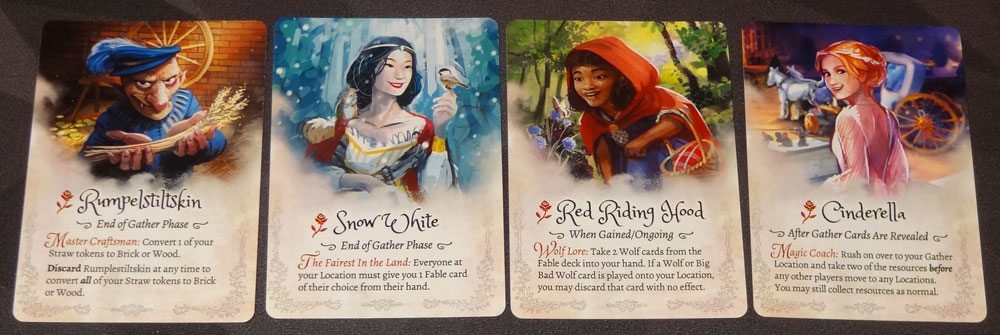
One thing I did like is that there is a little bit of diversity seen in the Friend cards. There are various characters from classic Grimm fairy tales, but not everyone is portrayed as Eastern European. Snow White is Asian, and Little Red Riding Hood is black. Most of the characters are still white, but I liked seeing a couple of non-white faces in the mix. (And, of course, there are animals and monsters.)
The resource tokens come in single-value tokens and “Mega-Resource” tokens: 5 straw, 4 wood, or 3 brick. These are tied to the amounts that you restock on the location boards each time, and they make the cleanup phase really easy. It’s a small addition that does a lot to speed up gameplay.
How to Play
You can download a copy of the rulebook here.
The object of the game is to be first to build three houses (of any material).
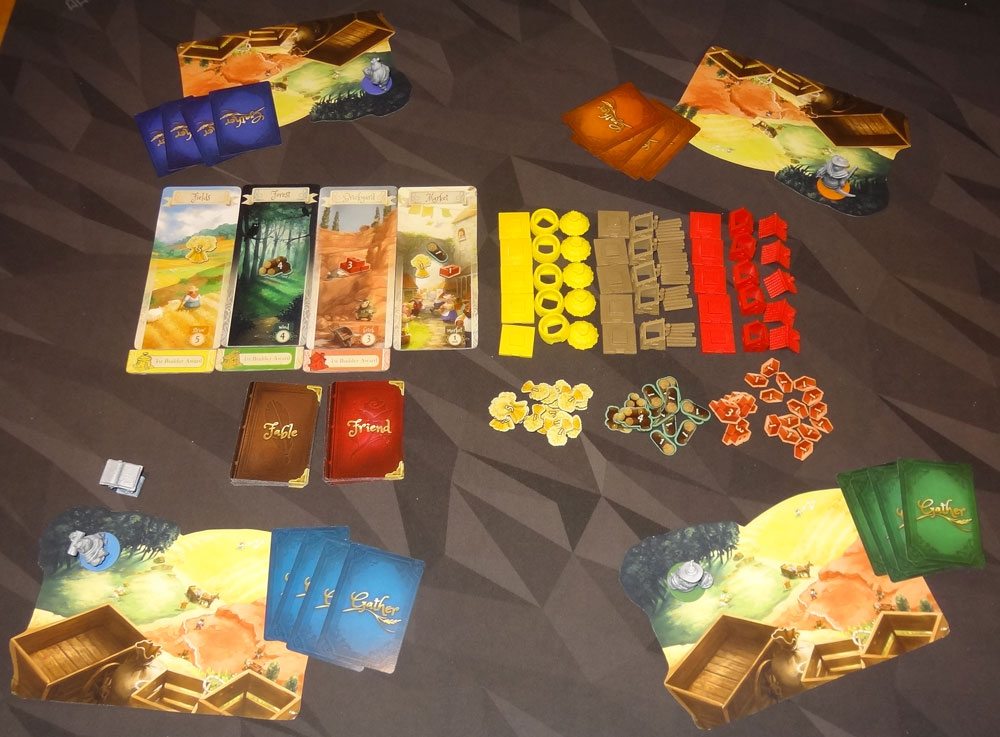
Each player gets a player board, Gather cards, and a pig miniature. The two decks of cards are shuffled separately, and the gather location boards are placed in the center of the table, along with all of the resource tokens. One player gets the Starting Player token. Add resources to the game board: 5 straw, 4 wood, 3 brick—the Mega-Resource tokens match these amounts. In a 4-player game, you include the “Market” Gather cards and Gather location board, but otherwise they are not used; the Market gets 1 of each resource.
Each round has a Gather Phase, a Building Phase, and a Cleanup Phase.

Gather Phase
Each player secretly chooses one of their three Gather cards (Straw, Wood, or Brick) and optionally one Fable card. Once everyone has chosen, Fable cards are revealed. Once those are resolved, the Gather cards are revealed and pig miniatures are placed in the corresponding locations on the board. Players divide up the resources available at the locations equally among the pigs present. If you’re the only one at a location, you get all of the resources. If there is a remainder, it stays on the board for the next round.
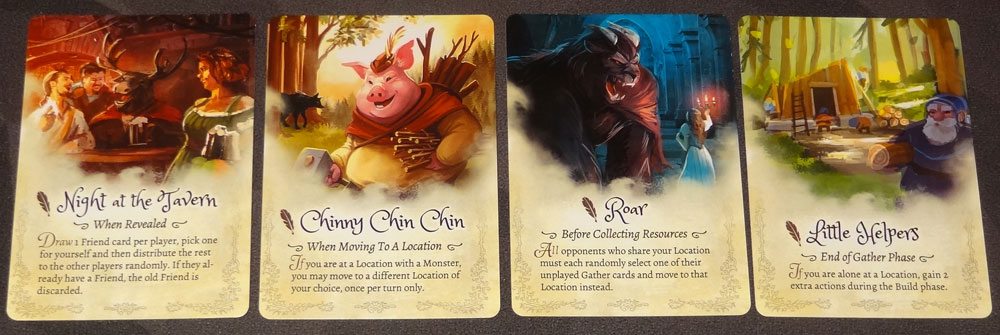
Building Phase
Each player in turn order gets 2 actions. You can choose any of the following (including repeating an action):
- Build 1 house section (costs: 2 for foundation, 4 for walls, 6 for roof).
- Draw a Fable card.
- Take 1 resource of your choice.
When building houses, you must build from the bottom up, and you can’t mix materials in a single house. You may have multiple houses under construction, but you may not start a house if you have an unfinished house of that material. You may only have up to two houses of each type.
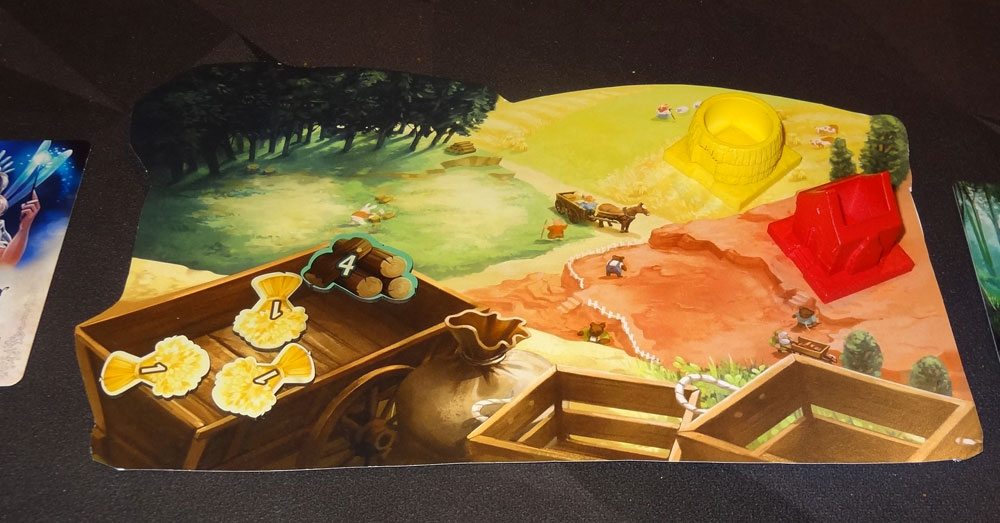
Every time you build walls, you get a Friend bonus. Draw the top Friend of the deck. Either keep it (and discard your old Friend, if any) or else give the new Friend to another player, forcing them to discard their old Friend. Friends give you various benefits during the game.
If you’re the first to complete a house of a particular building material, you get a bonus: 1 Friend (keep or force another player to take it), 2 Fable cards, or 1 of each resource from the supply.
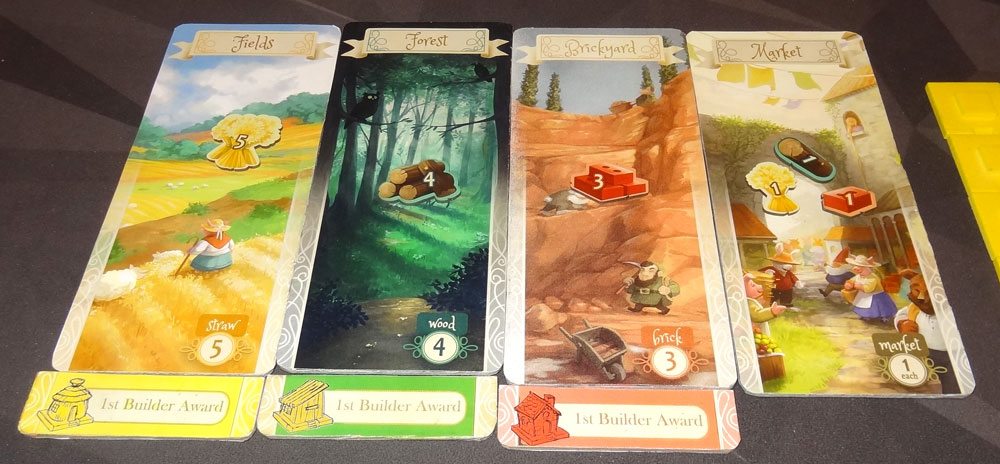
Cleanup Phase
After everyone has taken their 2 actions, the Starting Player token is passed, everyone retrieves their pigs, and then the Gather Location boards are restocked.
The game ends at the end of a round when any players have finished at least 3 houses. If there’s a tie for number of houses (because more than one player reached 3 in the same round), then the quality of the houses breaks ties.
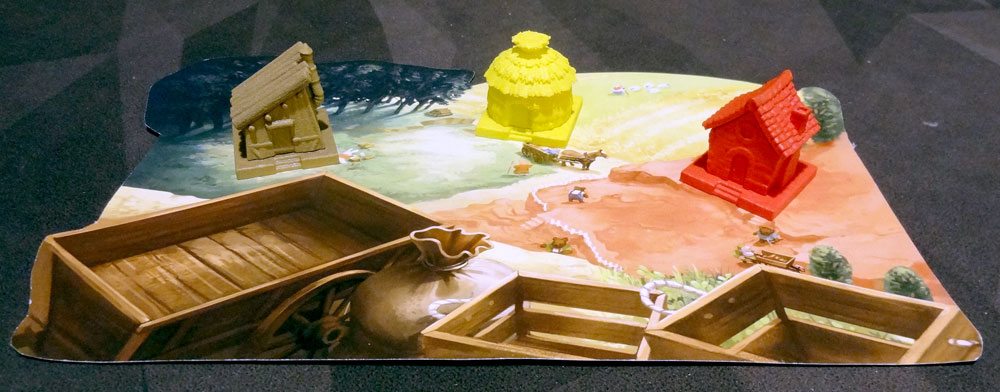
The 2-player game adds a dummy player called Prince Regal—basically each turn, you randomly draw one of Prince Regal’s Gather cards. Prince Regal goes to the location, takes half (rounded down) of the resources there (putting them back into the supply) and then goes away. He won’t ever share a location with anyone because that happens before the pigs arrive at the locations to gather resources.
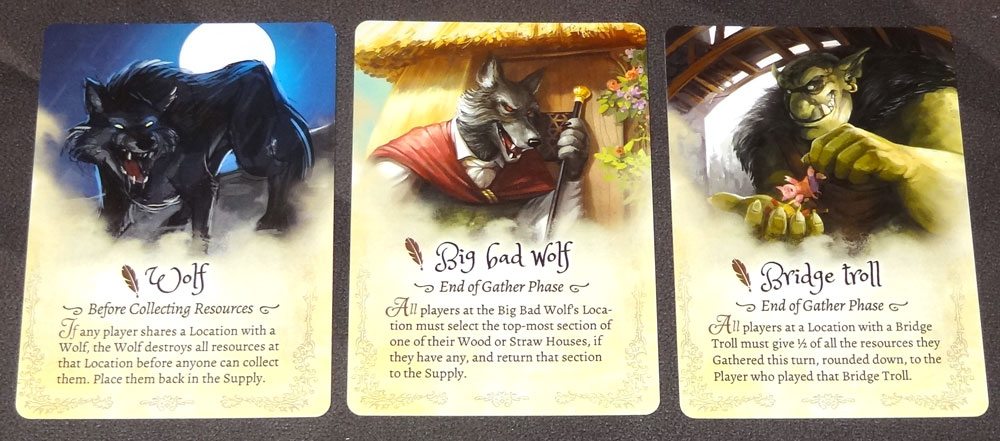
The Verdict
At first glance, Grimm Forest looks like a resource management game: you collect resources and use them to build houses. That’s true, but only partly. The key mechanic is the gathering–figuring out where other players are headed, and using that knowledge to your own advantage. On the first turn, it’s just sort of a gamble: do you go for Straw, because it’s more plentiful and it’ll be easier to gather? Or do you go for the Brick, because there’s not as much and maybe nobody will want to go there? Of course, if multiple pigs show up in the Brickyard, then that’s doubly bad.
Once you start collecting Fable cards, however, you have even more of an incentive to figure out what the other players want. Use a Wolf to wipe out resources from a location, or play Roar to try to scare other players away from your location. Powerful Friends can let you steal actions from other players at your location. Fable cards can be really powerful, but you’ll have to decide whether to use your precious Building Phase actions to draw Fable cards or get resources. Or, you know, build something.
Of course, there is still some resource management. Each house costs the same number of resources to build, but Straw is plentiful and Brick is scarce. You’ll have to work out the trade-off between building cheap Straw Houses or building Brick Houses that can’t be blown down by the Big Bad Wolf. Also, since you get a bonus for finishing a house type that nobody else has built yet, players often tend to specialize at least at first so they don’t have to race for a particular resource.
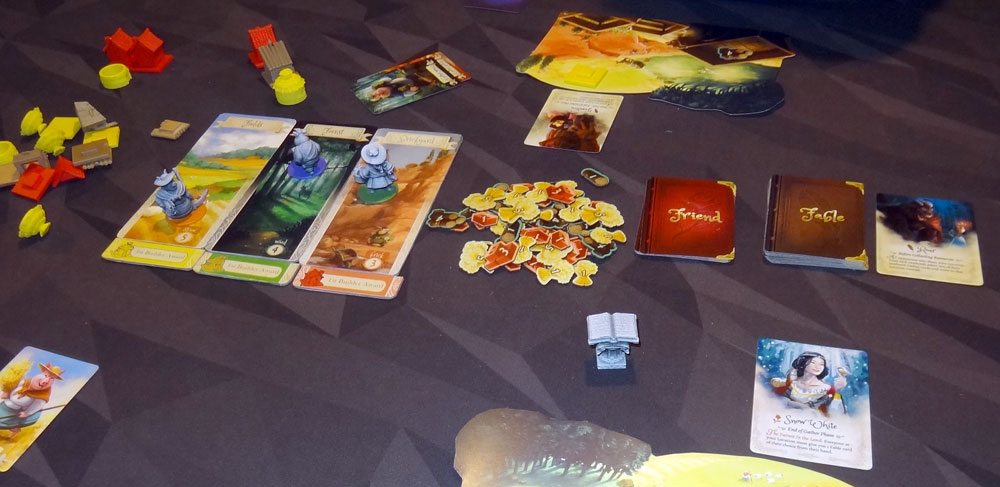
The Friends provide an interesting tweak. Each one has different abilities, but you have to build a wall (or get a first-builder bonus) to get one. The fact that you can send an unwanted Friend to another player is pretty fascinating—when you draw a Friend, you have to decide whether it is better than your current Friend—or worse than an opponent’s. Giving a Friend away means that you’re giving your opponent some sort of benefit–just one that you feel isn’t as good as the one they already have. That decision can be a tricky one.
The major differences between the original Little Pig design and this one are the addition of a 4th player option and the updated look (including the miniatures and house components). Adding a 4th player is significant, because limiting the game to 3 players cuts out a lot of gaming groups. The updated look is really nice, though all of that fancy artwork and the miniatures come at a higher price. Druid City Games is counting on folks who value a great-looking game; personally, I really like the way it looks now, but I also preferred the much lower price tag that the original version had.
I liked the fairy tale theme, particularly the way characters from other tales show up as Friends or on Fable cards. I’ve always liked to read new twists on fairy tales, so having a game that plays around with those themes is fun, too. Despite the age rating, I think this could be a good fit for families and younger kids. One thing I did think was a bit odd is that the title and the cover image make it look like it’s going to be somewhat dark and spooky. That, and the 14+ age rating, may give people the wrong impression of the type of game it’s going to be.
Overall, I found The Grimm Forest to be a great light-strategy deduction game that I can play with both my 10-year-old and my adult friends. I love simultaneous-selection games, and this is one that really rewards you when you can anticipate other players’ choices. There are some great, tough decisions to be made throughout the game, but the rules themselves are straightforward and easy to learn.
To find out more about the game or make a pledge, visit the Grimm Forest Kickstarter page!
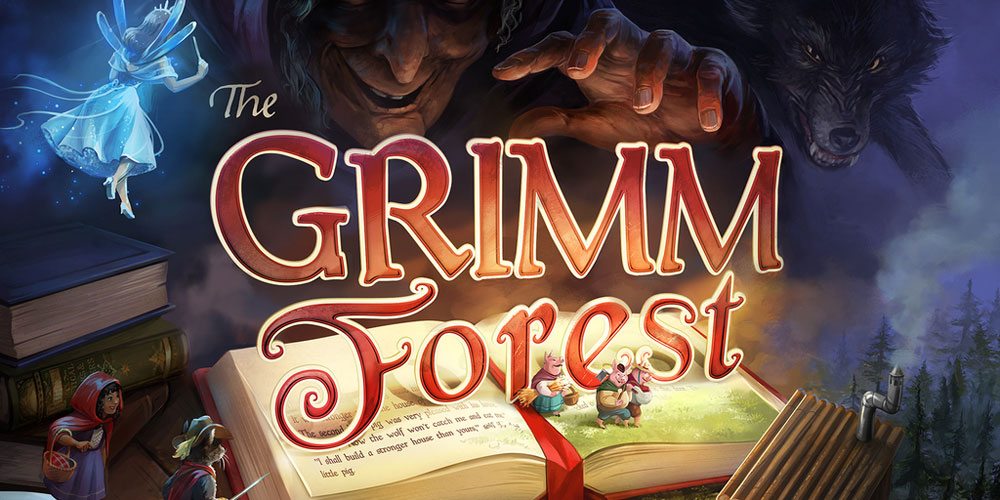


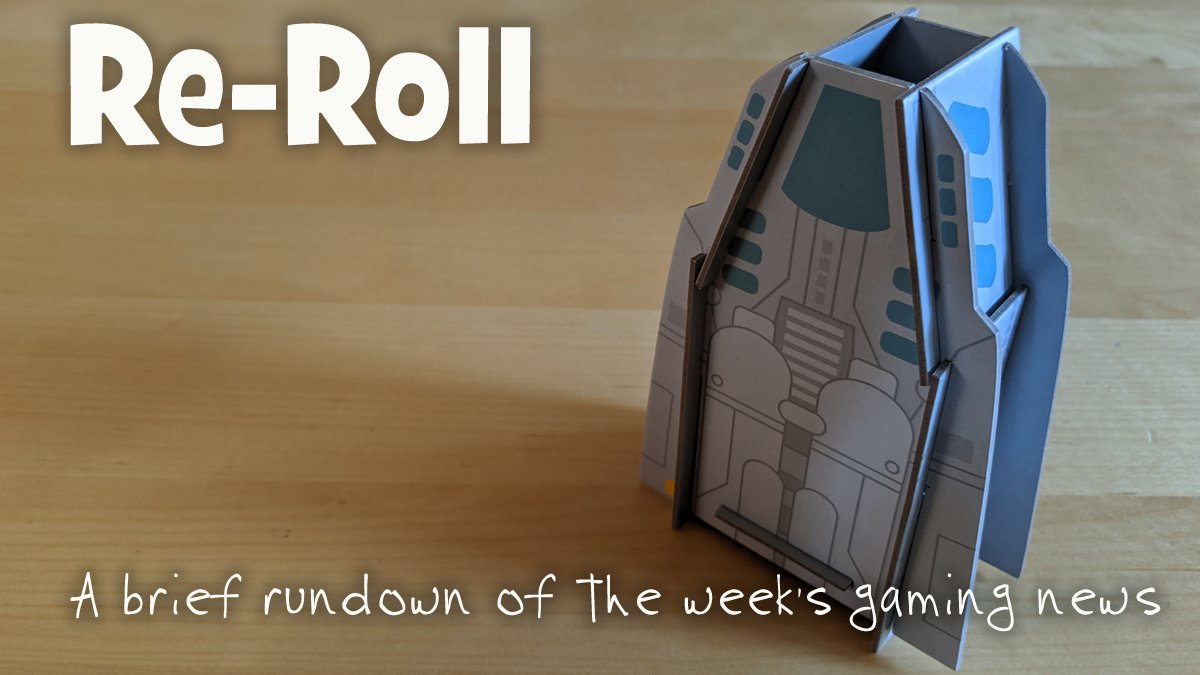
By all means, people should back this game. I’ve played it, and have watched it played many times. It is clever and engaging. My wife, who hardly plays any games at all, told me to be sure to back this when I just described having seen it for the first time.
Coming from a design background and loving fine art since I was small, I love the artwork. Love the fairy tale friends and how they interact with the game. My only qualm is the $50 for the pledge. Do everyone here think it’s worth it? I wanna play this with my toddler son when he got older, but until then I do wanna enjoy this with my BG friends.
Just backed Rising Sun and its expansion so I’m being very picky when it comes to backing new, wonderful-but-out-of-the-blue BG projects like this, lol.
I think the game itself is a lot of fun. I will admit that my biggest gripe with the game is the fact that it didn’t really need to have a bunch of miniatures (such as the monsters they’re including now with the stretch goals) to be a great game, but certainly those are attention-grabbing for the Kickstarter crowd. I do think it’s a very solid game, and the house models (which ARE more crucial to the game) are very cool, but you’re definitely paying a premium for the extra minis, so it depends on how much value you feel miniatures add to a game. The artwork is outstanding.
It’s a game that didn’t fund when it launched the first time at a $25 price point without fancy miniatures and with a different art style. I think it would have a been a great buy at that point. The gameplay has improved somewhat in this version (particularly since it’s now up to 4 players instead of limited to 3), but a lot of the added cost is the art, upgraded houses, and miniatures.
Ah I see, so this is actually a second round crowdfunding project?
Wow, thanks a bunch for your insights, opinion, and reply, really appreciate it 🙂
Haha true, it could be like King of Tokyo or Dead of Winter where they use cardboard standees instead of miniatures. But I agree with you, the miniatures and whatnot are for attention grabbing, PLUS any excess funding is always welcomed. For the art and fluff alone, I think my son will love it (by the time he can actually play it lol). I just have to make sure to read him Grimm’s fairy tales first.
Thanks again!